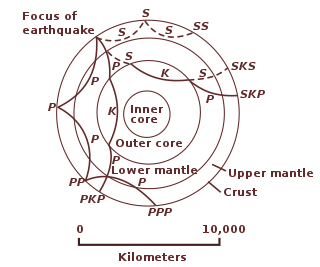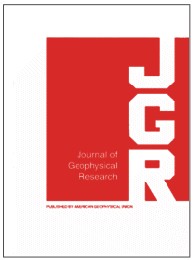
Geophysics is a subject of natural science concerned with the physical processes and physical properties of the Earth and its surrounding space environment, and the use of quantitative methods for their analysis. Geophysicists, who usually study geophysics, physics, or one of the Earth sciences at the graduate level, complete investigations across a wide range of scientific disciplines. The term geophysics classically refers to solid earth applications: Earth's shape; its gravitational, magnetic fields, and electromagnetic fields ; its internal structure and composition; its dynamics and their surface expression in plate tectonics, the generation of magmas, volcanism and rock formation. However, modern geophysics organizations and pure scientists use a broader definition that includes the water cycle including snow and ice; fluid dynamics of the oceans and the atmosphere; electricity and magnetism in the ionosphere and magnetosphere and solar-terrestrial physics; and analogous problems associated with the Moon and other planets.

The American Geophysical Union (AGU) is a 501(c)(3) nonprofit organization of Earth, atmospheric, ocean, hydrologic, space, and planetary scientists and enthusiasts that according to their website includes 130,000 people. AGU's activities are focused on the organization and dissemination of scientific information in the interdisciplinary and international fields within the Earth and space sciences. The geophysical sciences involve four fundamental areas: atmospheric and ocean sciences; solid-Earth sciences; hydrologic sciences; and space sciences. The organization's headquarters is located on Florida Avenue in Washington, D.C.
George Wetherill was a physicist and geologist and the director emeritus of the department of terrestrial magnetism at the Carnegie Institution of Washington, DC, US.

Geophysical Research Letters is a biweekly peer-reviewed scientific journal of geoscience published by the American Geophysical Union that was established in 1974. The editor-in-chief is Harihar Rajaram.

Andrew Emory Dessler is a climate scientist. He is Professor of Atmospheric Sciences and holder of the Reta A. Haynes Chair in Geoscience at Texas A&M University. He is also the Director of the Texas Center for Climate Studies. His research subject areas include climate impacts, global climate physics, atmospheric chemistry, climate change and climate change policy.
The historical development of geophysics has been motivated by two factors. One of these is the research curiosity of humankind related to planet Earth and its several components, its events and its problems. The second is economical usage of Earth's resources and Earth-related hazards such as earthquakes, volcanoes, tsunamis, tides, and floods.

Scott Ellsworth Forbush was an American astronomer, physicist and geophysicist who is recognized as having laid the observational foundations for many of the central features of solar-interplanetary-terrestrial physics, which at the time was an underdeveloped field of study. In 1937 Forbush discovered the Forbush Effect: an occasional decrease in the intensity of cosmic rays as observed on Earth that is caused by the solar wind and its interaction with the magnetosphere. Scott conducted most of his research during his career at the Department of Terrestrial Magnetism (DTM) of the Carnegie Institution of Washington where he was appointed chairman of a section on theoretical geophysics in 1957. Forbush used statistical methods in analyses of magnetic storms, solar activity, rotation of the Earth, and the rotation of the sun, and the correlation of this geophysical and solar phenomena with temporal variations of cosmic-ray intensity.
Reviews of Geophysics is a quarterly peer-reviewed scientific journal published by Wiley-Blackwell on behalf of the American Geophysical Union. The current editor-in-chief is Fabio Florindo.
Biogeophysics is a subdiscipline of geophysics concerned with how plants, microbial activity and other organisms alter geologic materials and affect geophysical signatures.

The following outline is provided as an overview of and topical guide to geophysics:

Planetary science is the scientific study of planets, celestial bodies and planetary systems and the processes of their formation. It studies objects ranging in size from micrometeoroids to gas giants, with the aim of determining their composition, dynamics, formation, interrelations and history. It is a strongly interdisciplinary field, which originally grew from astronomy and Earth science, and now incorporates many disciplines, including planetary geology, cosmochemistry, atmospheric science, physics, oceanography, hydrology, theoretical planetary science, glaciology, and exoplanetology. Allied disciplines include space physics, when concerned with the effects of the Sun on the bodies of the Solar System, and astrobiology.

Stephen J. Mackwell is a researcher in geophysics, specializing in laboratory-based studies of the physical, chemical and mechanical properties of geological materials. He is also interested in the transport of fluid components in mantle and crustal rocks on the microscopic and macroscopic scales, and on the effects of such components on mechanical properties. He has authored or co-authored over 80 articles in international scientific journals and is an editor of a book on comparative climatology of terrestrial planets published by the University of Arizona Press.
Maureen D. Long is an observational seismologist studying mantle and Mesosphere dynamics. She currently serves as a professor at Yale University within the Department of Geology and Geophysics.

George L. Siscoe was an American physicist and professor emeritus of space physics at Boston University. He made major contributions to the understanding of the Earth's magnetosphere and the heliosphere, particularly in helping to establishing the field of space weather and the term heliophysics - a term which is now standard use.
Oliver Holmes Gish was an American geophysicist, known for his research on atmospheric electricity and earth currents. He "contributed to our understanding of magnetic storms and the daily variation of the geomagnetic field."
Subir Kumar Banerjee is an Indian-American geophysicist, known for research on rock magnetism, palaeomagnetism, and environmental magnetism.
James Gregory "Greg" Hirth is an American geophysicist, specializing in tectonophysics. He is known for his experiments in rock deformation and his applications of rheology in development of models for tectonophysics.
Thomas A. Herring is a geophysicist, known for developing and applying systems of space geodesy to high-precision geophysical measurements and geodynamic research.
Tonie Marie van Dam is an American geophysicist and geodesist, known for her pioneering research on solid Earth deformations due to loads from atmospheric and hydrologic pressures. She and her collaborators used space geodetic observations and modeling for increased precision in measuring and understanding such loads.









